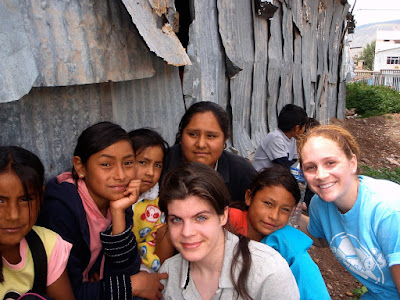What a crazy week it’s been!
Since all the health clinics are still on strike Laura, Natalie, and I have been floating around volunteer placements. Tuesday and Wednesday we worked at “InaBif”, or what we call the “Drop-in Center”. It’s this little building in the middle of a market where children who work at the market can come to hang out (i.e. not work) for a while. We bring art supplies, cards, games, etc. and just play. On Tuesday we played soccer at a nearby blacktop for a while with the boys, and then played endless clapping games with the girls (Quack-diddly-oso was a big hit). On Wednesday we brought some fruit loops and string to make fruit loop jewelry, played cards, and more clapping games. The niños are beyond adorable, and they loved all their “gringa Profesoras”!
Kaitlan, Drop-in Center niños and I
Betsy painting my fingernails with marker
The Drop-in Center is in the middle of this market
Later that day we had a lecture on the role of the Coca leaf in Peruvian culture. It was crazy! Basically, Coca plants have been cultivated by Peruvians since before the Incas, and because of this, use of the leaf is a huge part of their culture. The reason for its original popularity comes from the fact that when chewed properly, Coca leaves release trace amounts of naturally occurring Cocaine alkaloid, giving the chewer energy, simultaneously decreasing appetite and thirst. Apparently the only negative effect of chewing Coca leaves is a discoloration of the teeth; it’s not addictive and hasn’t been linked with any heath problems. Because of these properties, it’s been used for centuries as offerings to gods, given as gifts, chewed, and used in food. In Peru alone, they produce 110,000 tons of dry Coca leaf annually, and of that, 10,000 tons are use for legal purposes. (FYI: Coca-Cola still uses Coca leaves in their soda, sans the Cocaine alkaloid; they import over 170 tons of Coca leaves per year!). As you might guess from the large difference in total tons produced and tons used for legal purposes, the remaining 100,000 tons of Coca are used for the illegal production of pure Cocaine. Peru produced 310 tons of pure Cocaine in 2009, half of which was made in the Ayacucho region (as it’s one of the few provinces that has Andean jungle; the only place where Coca can grow).
After the lecture we had our Coca Leaves read; the Peruvian version of Taro cards. It was so fun! The Professor warned us before hand that since Quechua is the traditional language of Peru, he would have to speak to the Coca leaves in Quechua. In the midst of all the Coca-confusion, though, he spoke in French, English, Spanish, and Quechua mixed together…A little confusing to say the least. As for my results, apparently I will be a doctor one day, as long as I’m willing to work really hard for it, I have weak ankles, I should never drink ice water, and if I’m going to Asia anytime soon, Northern India, Japan, and Thailand are okay, but I should avoid Cambodia and Vietnam… How does he do it???
Thursday Laura and I went to the “Casa Para Los Ancianos” (Old folks home), which turned out to be quite the experience. First of all, the building is huge and beautiful; the women’s courtyard even has a garden whose centerpiece is a giant birdcage that houses peacocks and doves. When we first walked out to the courtyard of about 30 ancient looking women, we were greeted for the most part by a few nods and stares—the obvious exception being our greeting from Tomasa. This mute (but by no means silent) woman ran up to us, gave us each an enthusiastic kiss on the cheek, and immediately wanted to see what we had brought for activities. We were told by other volunteers to bring paper and markers, a ball, and some Legos. I was skeptical that any of these women would be interested in coloring—let alone playing catch—but I was very wrong. When Tomasa saw we had brought coloring gear, she scurried off and came back with her own Little Red Riding Hood coloring book, and we ended up coloring for the better part of an hour. Slowly, more and more women joined our group, and when interest in coloring and Legos ran out, we played catch for another hour or so. Tomasa—very spunky for her age—kept faking like she was going to throw the ball really hard at someone’s head, and when they flinched everyone would laugh. She only actually pegged someone once (with a very soft ball), and luckily they were a good sport about it.
Friday we went to the prison, knitted (an extreme obsession at the CCS house; I’m currently working on a hat with a “knit two, purl two” pattern), played with the kids, and talked with the women, etc. After lunch I then rushed off to “GiGi’s school”, which is an after-school program run by an American woman. It’ a really amazing program. GiGi is essentially trying to fill in the educational holes for elementary school kids who have been victim to the sub-par/inconsistent Peruvian education system. She focuses on the basics: math, reading, and writing, with some “special lessons” mixed in, like hygiene, controlling emotions, and healthy eating. I definitely want to go back there again!
As a side note: Peruvian aerobics classes are nuts! I’ve gone twice now, and both times I’ve wished I grew up dancing like a Latino woman, because it would make the moves they do in class a lot easier… haha. Great workout, though!
Another side note: I couldn't help but post this picture below... Someone's prized cow tied up on a busy street in Ayacucho. Only in Peru.
Another side note: I couldn't help but post this picture below... Someone's prized cow tied up on a busy street in Ayacucho. Only in Peru.






No comments:
Post a Comment